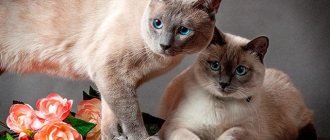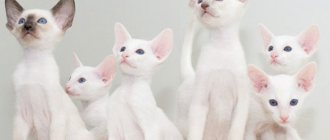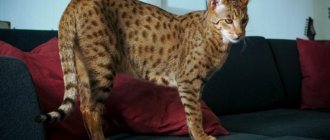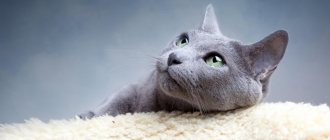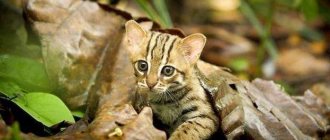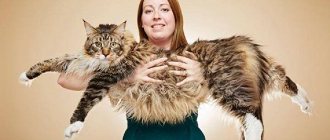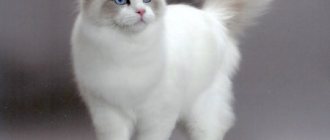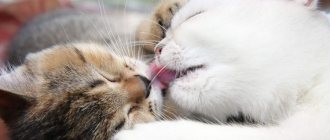The Neva Masquerade cat is an independent subspecies of the Siberian breed with sky-blue eyes and color-point colors. These furry creatures combine natural grace, strength and a very gentle character.
Let's figure out where this breed came from, how to care for it, how to choose the right kitten, as well as other issues that the future owner of a Nevaka needs to know.
Brief history of the breed
The Neva Masquerade appeared in the 80s of the last century. It is reliably known that its ancestor was a Siberian cat. But where the Nevakasiam color comes from has not yet been established exactly.
According to one version, the unusual fur coat is a sign of kinship with pointing Persians. According to another theory, this is the result of mating Siberian cats with Siamese.
The work on breeding Nevaks was led by Olga Mironova, a well-known Leningrad felinologist and an international expert. In 1988, representatives of the breed were demonstrated for the first time at an exhibition.
As masquerade cats became popularized, metropolitan breeders became interested in them. The Moscow team of felinologists worked independently of their Leningrad colleagues, thanks to which the Nevaks had several color options.
In the late 80s, the cat breed, which was bred by St. Petersburg felinologists, began to be popularized abroad. In 1992, the Neva Masquerade received recognition from the WCF. But most felinological associations still consider the breed to be a variety of Siberians.
Interesting Facts
Despite the relative youth of the breed, the origins of which are the St. Petersburg felinological club “Kotofey”, a lot of interesting things have already happened to the Neva Masquerade cat:
- Some experts are sure that the unusual color of these cats is a consequence of the manifestation of the recessive albinism gene, which gives the color-point color.
- The saliva of Neva masquerade monkeys contains a minimum of antigens. Therefore, cats of this breed rarely cause allergies.
- The Neva Masquerade cat named Blue-Eyed Angel starred in the Hollywood film “Nine Lives”.
- The breed owes its name to the unusual pattern on its face and the river on which the Northern capital of Russia stands. In an abbreviated version, the name sounds like “newak” or “carnival cat.”
Diseases
The Neva masquerade cat has a strong immune system. There are quite a lot of long-livers among individuals of this breed, with a third having crossed the 20-year mark. But there are a number of hereditary diseases that the owner should be aware of.
Hypertrophic cardiomyopathy is a thickening of the heart wall. This pathology is not detected in the early stages, but symptoms can be gradually tracked. The cat becomes lethargic, runs and jumps less, and develops shortness of breath and wheezing. The disease cannot be cured, but supportive therapy will help extend the pet’s life for several years.
In cats over 8 years of age, kidney failure is often diagnosed. A special diet, therapy and control by the owner will help support the body.
Vaccinations are mandatory, even if your cat does not go outside. Caused by such terrible diseases as calcivirosis, rhinotracheitis, panleukopenia, they can enter the house on your hands, on the soles of shoes or with outer clothing. Without vaccinations, these diseases most often result in the death of animals.
The problem with many cats is hairs getting into their stomachs. They roll into balls - bezoars, are not digested, and can cause digestive system upset. In order for these balls to come out, the cat causes a vomiting reaction by eating sprouted oats or wheat. Therefore, do not forget to plant these cereals at home. Additionally, you can give a special paste.
In the photo there are kittens of the Neva Masquerade breed
Breed description, standards, appearance
Nevaki are representative cats with pronounced aristocratic manners. The main distinguishing feature of the breed is considered to be a luxurious, elegant fur coat that harmonizes with sky-colored eyes.
Visually, the Neva masquerade cat resembles its Siberian ancestor. A detailed description of the breed is presented in the standard developed by the IFA system in 1990.
Dimensions and weight
Neva Masquerade cats are large cats with strong bones, a dense build and pronounced sexual dimorphism. The standard sets clear requirements for the size of adult individuals. The female weighs 6-7 kg, the male weighs 8-10 kg.
The Neva masquerade kitten is born weighing 120-160 g and grows quickly. To understand how correctly it is developing, a special table has been developed that shows the weight by month.
| Age, months | Weight, kg |
| 2 | 1,2-1,6 |
| 3 | 1,8-2,3 |
| 4 | 2,5-3,8 |
| 5 | 3,0-5,5 |
| 6 | 3,9-6,2 |
| 7-8 | 4,2-6,9 |
| 9-11 | 5,0-8,4 |
Anatomical characteristics
A typical representative of the Neva Masquerade breed should meet the following description:
- The head is proportional, trapezoidal with smooth outlines, a low rounded forehead, a wide nose and low cheekbones. The chin is powerful, the jaws are developed, the cheeks are plump. There is no stop.
- The eyes are slanted and rounded. The iris of masquerade cats is colored blue. Nevaks of red point color have eyes that appear deep blue.
- The ears are medium in size, wide at the base, with rounded tips. Slightly tilted forward. The outer contour of the ear begins just above eye level.
- The body is harmonious, of medium length with massive bones, a short neck, developed muscles and a voluminous chest.
- The limbs are strong, moderately long with large round paws. The interdigital space is overgrown with tufts of hair.
- The tail is of medium length and looks like a fox's. With a rounded tip and rich edge.
Color and coat type
The entire body of the Neva masquerade cat is covered with long or semi-long hair with a water-repellent effect. The hair on the back is coarser, while the hair on the sides is softer. An important characteristic of a chic Nevaka fur coat is the lack of tendency to form tangles.
Representatives of the breed have very developed decorative hair. Neva masquerade cats have thick “pants” on their paws, a “collar” on their necks, and a luxurious “jabot” on their chest. During the molting period, the decorative hair completely disappears.
Under the outer coat of cats of this breed there is a double down, which thins out in the summer and becomes thicker in the winter.
On a note. The Neva Masquerade is only fluffy. A smooth-haired or short-haired cat, at best, will turn out to be a representative of a different breed, at worst, a mestizo.
The Neva Masquerade standard allows for several color options. According to him, the following colors are found in the breed:
- tortoiseshell point - combines red and black shades;
- silver point – provides for the presence of a silver color;
- tabby point – there are pronounced stripes in the dark areas;
- red point - with cold zones of red and red colors;
- blue point and blue tabby point - there are blue and gray shades;
- seal point and seal tabby point - with black or dark brown markings.
On a note. Neva Masquerade kittens have snow-white fur at birth. As they grow older, dark markings appear on their body.
Possible breed defects
Flaws in appearance, in the presence of which a non-vacant cannot receive a high expert assessment:
- thin or long limbs;
- small, deep-set or completely round eyes;
- narrow or elongated muzzle;
- ears set too high, low or too close;
- weak bones;
- lack of hair in the interdigital space;
- Long neck;
- hairless or pointed tail;
- small paws;
- Coarse, patchy or dull coat;
- point in chocolate-lilac tones.
Weight by month
Males weigh up to 10 kg, females - 5-6. Height (height at withers) - 25-40 cm.
| Age | Cat | Cat |
| 1 month | 250-470 gr | 370-680 gr |
| 2 | 460-820 gr | 770-1450 gr |
| 3 | 0.9-1.5 kg | 1.4-2.3 kg |
| 4 | 1.6-2.3 kg | 1.8-3.6 kg |
| 5 | 2.1-3.3 kg | 2.3-4.2 kg |
| 6 | 2.5-3.6 kg | 2.9-5.6 kg |
| 8 | 3.1-4.4 kg | 3.5-6.4 kg |
| 10 | 3.2-4.6 eg | 5.1-7.1 kg |
| 1 year | 3.4-5.4 kg | 5.8-7.7 kg |
| 2 and older | 3.6-6.5 kg | 7.5-9 kg |
Character and temperament
The Neva Masquerade is a calm cat with an easy-going disposition and a stable psyche. She is never intrusive and rarely loses her temper. Despite its balanced character, the Neva Masquerade is a cheerful cat that remains playful into old age.
Representatives of this breed are true individualists with aristocratic manners. Nevaks demand respect and forever lose trust in anyone who even once yells or hits them.
On a note. Affectionate and patient Neva masquerade cats subtly sense not only the mood, but also the state of health of their owners. They can lie on sore spots.
Breed and children
Neva Masquerade gets along well with children of all ages. An adult cat condescendingly watches childish pranks and is patient with their “caresses.” But a newborn kitten, carried away by play, can bite or scratch the baby.
Breed and other animals
The Neva Masquerade gets along well not only with its brothers, but also with friendly dogs. A cat of this breed can coexist peacefully with birds and small rodents, but only if it grew up with them. Otherwise, the Nevak will perceive them as prey.
Characteristics of a masquerade cat
The character of a masquerade cat can easily be called golden. These are very calm animals that know how to show a sense of tact and unobtrusiveness. Neva beauties love to show off their chic by walking in front of their owner. However, if attention is not paid to them, they do not insist on their company and patiently wait for a more favorable moment to communicate with a person.
The Neva Masquerade cat is very attached to its owner and family members. They are the ones who come first among all other people. Guests who visit the house can only enjoy the contemplation of the handsome man, since they are strangers to the newcomers.
The Neva kitten is a true friend for children . Even in adulthood, pets can show moderate mobility and willingly join in games. For a family with children, such a four-legged creature is ideal. A cat will never scratch a child; on the contrary, it will do its best to create a comfortable company for him.
global $ads_google; //data-ad-slot=”2475549904″ $ads_google = empty($ads_google) ? false : true; ?> if ($ads_google == false) {?> $ads_google = true; ?> } ?>
Thanks to its high intellectual abilities, the Neva Masquerade Dog quickly adapts to the home, is easy to train, responds to its name and is accustomed to the litter box. In addition, these domestic cats cannot be called vindictive. Even having had an unfavorable experience with humans or other animals, they will not take revenge. But still, sometimes cats can be stubborn in nature. For greater contact and mutual understanding, the owner needs to build a partnership with his friend, avoiding insults and ignoring the pet.
If fellow animals appear in the house, then the cats gladly accept them into their society. They are quite tolerant not only of dogs, but also of the feathered inhabitants of the apartment.
Owners of purebred cats leave only positive reviews about the character of this beautiful breed.
How to choose the right kitten
To be sure that the animal is purebred, you need to buy it from trusted breeders or nurseries that specialize in breeding this breed of cats. A small Neva Masquerade must have a certificate confirming its origin, and a veterinary passport with vaccination marks.
After making sure that everything is in order with the documents, you need to pay attention to the conditions in which the kittens and their mother are kept. The nursery should be clean and comfortable. Little nevaks who grow up in decent conditions do not show signs of cowardice or aggression. They are not afraid of extraneous sounds and do not hide from strangers.
Healthy Neva Masquerade kittens have clean eyes and ears, soft bellies, fluffy fur and smooth skin without scratching or rashes. They do not have an unpleasant odor from their mouths or dirt under their tails.
On a note. To reveal the character traits of the nevak you like, you need to start a game with the kitten. It also doesn't hurt to observe the mother cat's behavior a little, since many traits are inherited.
Kitten care
Responsible and competent breeders sell Neva Masquerade kittens no earlier than they are 3 months old. By this age, babies can already exist without a mother.
Three-month-old nevaks eat many foods on their own, are accustomed to a scratching post and go to the tray. Therefore, new owners can only show their pets where they can eat, rest and relieve themselves, and also give them time to adapt.
Especially for the arrival of a Nevak kitten, they buy a “dowry” for it:
- tray and filler;
- bed or house;
- several toys;
- grooming tools;
- hygienic cosmetics;
- bowls for food and water;
- carrying bag
For safety reasons, wires, indoor plants, household chemicals, and fragile and small objects are hidden from the small Neva Masquerade breed. And to avoid unnecessary stress, at first the kitten is fed what the breeder advised. New foods are introduced into the Nevak’s diet gradually and the reaction of the pet’s body is carefully observed. While the kitten is small, it is fed little by little, but often:
- 3-6 months – 4 times a day;
- 6-11 months – 3 times a day.
A one-year-old Neva masquerade cat is transferred to two meals a day.
Catering
The health of your pet largely depends on a properly selected menu and the quality of products (or food). So what should you feed the Neva Masquerade?
Natural products
Natural nutrition has several nuances:
- Firstly, you cannot feed the nevak what you eat yourself: dumplings, spicy and salty soups, fried potatoes and other “delicacies”. The cat’s gastrointestinal tract will simply “fly” and you will have to treat it for indigestion, cope with diarrhea and other “delights” of poor nutrition.
- Secondly, many foods are contraindicated for cats. Smoked, sweet, salty, flour, baked goods, juices and carbonated water, dog food and human canned food, potatoes, citrus fruits, sugar and salt, seasonings and ketchups, river fish, pork and fatty meats - the list is huge! Do not give bones under any circumstances - even small ones can get stuck in the throat, scratch the mucous membrane, and ultimately pierce the stomach. Lard and tripe are also prohibited, as are sausages, sausages, potatoes, eggplants, and almost all fruits (with the exception of melons, apples and bananas).
- Thirdly, you can’t feed your cat! This leads to the development of obesity, followed by associated diseases (such as diabetes, heart problems, etc.). Cats older than six months eat 2 times a day, from 4 to 6 months - 3-4 times a day, under 4 months - 5-6.
The following products should be present in a cat's diet:
- Lean meat: veal, turkey, rabbit, beef (every day);
- Sea fish: hake, trout, salmon, flounder (no more than once a week);
- By-products: liver, kidneys, hearts, ventricles (2-3 times a week);
- Cereals: buckwheat, pearl barley, barley, oatmeal, rice, millet (every day);
- Vegetables: pumpkin, carrots, zucchini, green salad, parsley, dill, green beans, green peas (every day);
- Dairy products: yoghurts without dyes and harmful additives, low-fat sour cream, cottage cheese, fermented baked milk, kefir, yogurt (every other day);
- Oils: vegetable, olive or flaxseed;
- Purified water at room temperature.
Recommended food
Many breeders choose dry and wet food of the holistic and super-premium classes: they are made from high-quality products, undergo all the necessary treatment against parasites and pathogens, and contain a complex of vitamins and minerals necessary for the animal.
Holistic feed: AATU, Farmina N&D, Nutram.
Super-premium food: 1st Choice, Airi, Brooksfield, Landor.
Below are recommended holistic foods. Links with the names of the food are clickable, on them you can, within our website, get acquainted with the descriptions of the food and read reviews from owners of cats of the Neva Masquerade breed.
| Holistic | Holistic | Super premium |
| Jaguar | Riverwood | Josera |
Care and maintenance
Neva masquerade cats are unpretentious animals that adapt to life in any conditions. Both a city apartment and a private house are equally suitable for keeping representatives of the breed.
For a newbie, be sure to provide a cozy place to sleep and a secluded corner for the toilet. The litter tray for a large shaggy cat of this breed is wide and deep, and the filler is filled with large granules. Otherwise, caring for nevaks comes down to simple hygiene procedures and a balanced diet.
- To remove yellowish plaque and prevent the formation of tartar, brush your cat's teeth weekly. This is done carefully, using a silicone brush and a special paste that does not foam.
- The Nevak's eyes and ears are regularly examined for the presence of purulent or foul-smelling discharge and wiped with cotton pads soaked in warm boiled water.
- As they grow, the claws of a cat of this breed are shortened with a nail clipper, trying not to damage living tissue.
- The Neva Masquerade is bathed more often than representatives of other breeds. This cat is given bath treatments approximately once every 4-5 weeks. Wash the Nevaka with special shampoos for long-haired breeds, and then rinse thoroughly and dry with a silent hairdryer.
- The Nevaka's chic thick fur coat requires special attention. It is combed out 3-4 times a week with a special comb and a massage brush. During the molting period, the procedure is carried out daily.
Important! During the combing process, it is strictly forbidden to touch the Nevak’s tail. As a result of careless handling, it easily loses its beauty, and it takes a lot of time to restore the structure of the hairs growing on it.
Feeding the cat
Nevaks are unpretentious in food. They eat regular foods and dry food with equal appetite. With a natural type of nutrition, the diet of a cat of this breed is designed so that it is dominated by fresh, lean meat.
Nevaka is also given:
- porridge with water;
- dairy products;
- boiled and pureed vegetables;
- offal;
- lean sea fish;
- eggs.
It is strictly forbidden to feed a nevak with pork, onions, chocolate, river fish, pickles, smoked meats, sausages, pastries, sweets and any leftovers from the master's table.
With an industrial type of nutrition, a masquerade cat is given premium or super-premium class products, which contain all the useful substances and no questionable ingredients.
The best food for nevaks is:
- Brit Care;
- Eukanuba;
- Royal Canin;
- Farmina.
Education and physical activity
The Neva Masquerade cat is endowed with high intelligence and is easy to train. She quickly adapts to new conditions, gets used to her nickname and gets used to the tray. True, under certain circumstances, a Nevak can be stubborn.
Cats of this breed are natural hunters with excellent reactions. To realize this instinct, Nevaks need to walk in the yard.
If this is not possible, then a corner equipped with shelves and ladders is allocated for the pet.
Vaccinations and antiparasitic treatment
In order to prevent infectious diseases, the Neva Masquerade is vaccinated against calcivirosis, panleukopenia and rhinotracheitis.
- The first vaccination is given to a cat at the age of 7-8 weeks.
- After 4 weeks it is repeated, but with an anti-rabies component.
- In the future, the Nevak is vaccinated once a year.
To prevent the appearance of fleas and worms, the cat is regularly subjected to antiparasitic treatment. Anthelmintic drugs are given to Nevak once every six months and repeated after 10-14 days. To remove fleas, special shampoos, drops and collars are used.
Pros and cons of the breed
Owners of Neva Masquerade breed cats respond about their pets mainly in a positive way. Negative reviews from owners mainly concern the animals' excessive shedding and the need to devote a lot of time to caring for the coat.
Like cats of any other breed, Nevaks have both advantages and disadvantages:
| pros | Minuses |
| Attractive exterior | Heavy shedding |
| Cleanliness | |
| High intelligence |
Neva masquerade cats are fluffy animals with an unusual color. They successfully combine external beauty, an easygoing, friendly character and high intelligence. All this more than compensates for the need to regularly clean up balls of cat hair.
Buy a Neva Masquerade cat kitten
global $ads_google;
//data-ad-slot=”2475549904″ $ads_google = empty($ads_google) ? false : true; ?> if ($ads_google == false) {?> $ads_google = true; ?> } ?> Stunningly affectionate and beautiful cats called “masquerade” cats are now at the peak of their popularity. They are very loved in Europe, America, and other parts of the globe. The countries of the former Soviet Union are no exception. Currently, you can buy a Neva masquerade kitten in a nursery in Russia, Belarus, and Ukraine.
It is best to purchase a Neva Masquerade breed kitten in nurseries. Certified breeders guarantee the health and fitness of the animal.
The average price for a purebred kitten with a pedigree is 20,000 rubles. The cost depends on many factors, such as pedigree, color, title of parents and much more.
What to name a Neva kitten
After you have a baby and you have prepared food, a tray and a house for him, the most important question remains the name for the masquerade kitten.
You can come up with a nickname based on color, coat length, or simply the nature of behavior, or you can use the names suggested in the table. Nicknames for Neva kittens
| Girl | Boy | ||
| Gemera Veysi Zola Tyapa Zest Shunya Aphrodite Alicia Saba Riana Lola April Yana Blondie Share | Shila Button Lesya Sarbona Cornelia Chris Lariska Goldie Ricky Eva Yesya Flera Lariska Pistachio Flash drive | Laertes Willis Kotofey Walter Citron Bolero Fred Mirlan Kim Zorro Martin Philip Zabiyaka Curb Podeli | Saltan Flint Sharkhan Volt Bayan Joy Spark Charlie Nick Kotofey Darling Bim Valley Bobblehead Mityai |
Conclusions about St. Petersburg masquerade parties
The Neva Masquerade cat breed, which appeared not so long ago, managed to become one of the favorite varieties in a short time. And it’s not just about the “star” appearance. A balanced temperament, a friendly attitude towards people and strong heredity played a role.
Having once appeared on the feline catwalk of beauty, cats and female cats of the Neva breed have firmly entered the list of noble representatives of the family. This honor was rightfully given to them. The deep, amorous look of blue eyes and endless devotion to humans guarantee these pets many more years of human recognition.


